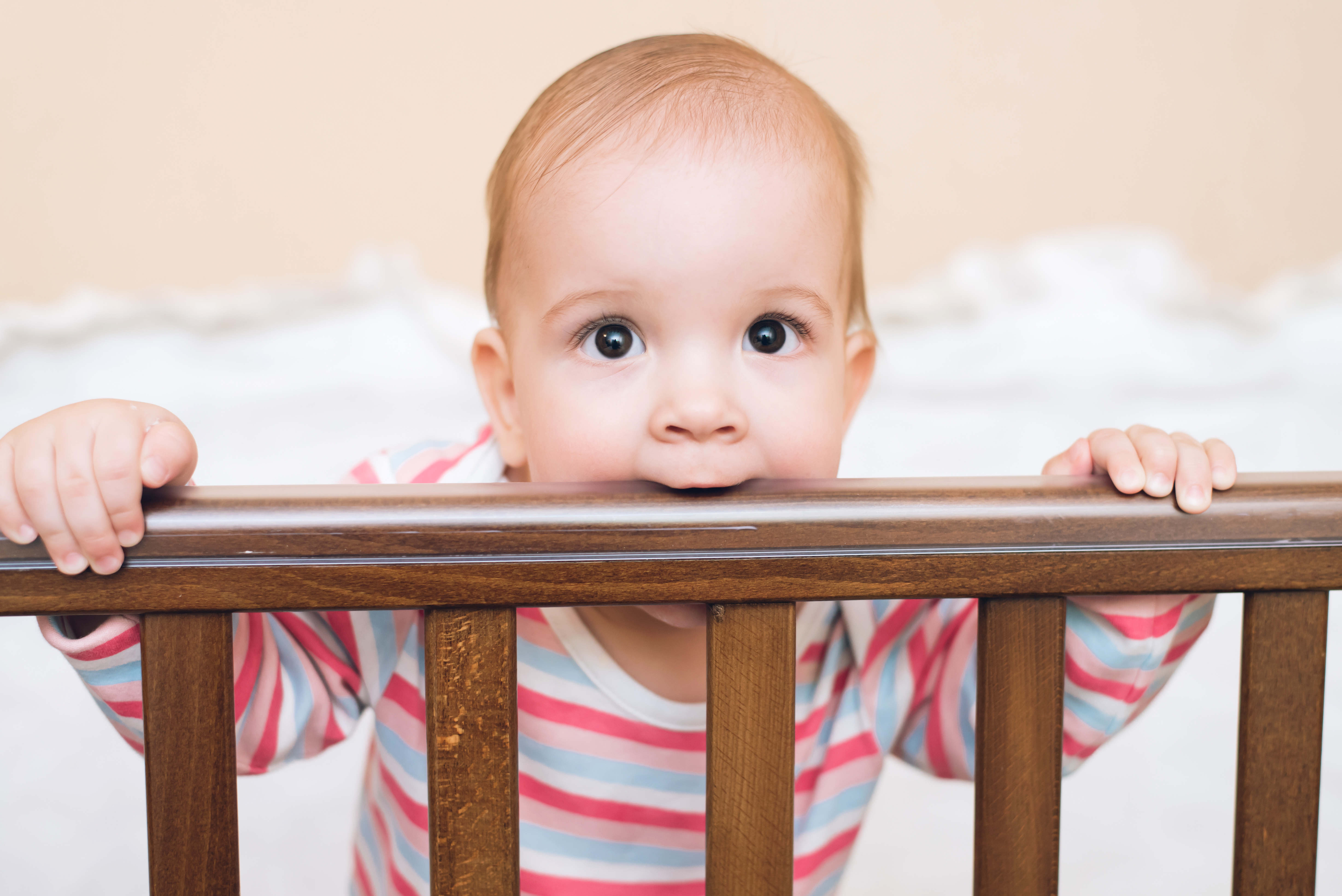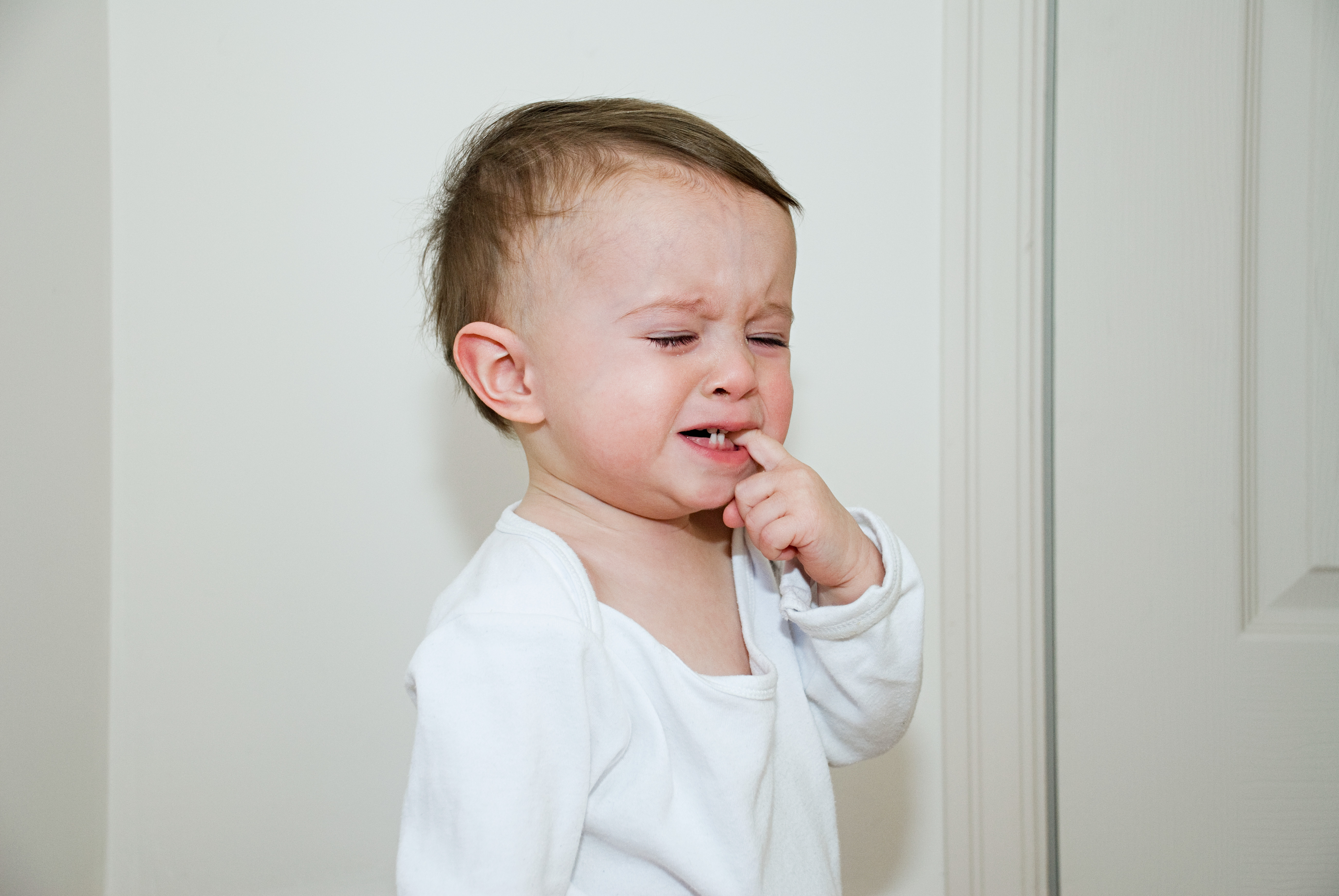Children chew on everything. They chew on their shirts and furniture and sometimes bite their parents. It is so challenging because toddlers are constantly putting stuff in their mouths. Parents don’t always know the reason kids put stuff in their mouths.
Babies and toddlers probably put everything in their mouths because they are teething. There are ways to help. Parents can use safe sensory activities, teething rings, and foods to help toddlers who constantly chew on stuff.
It is common for babies, toddlers, and even preschoolers to chew on everything –including furniture, clothing, and toys. Their slimy drool is probably a good indicator that they are just teething. Use some tools and get creative with your environment to help them through this stage of development. Let’s chat about teething, chewing, and ways to help infants and toddlers in pain from teething.

This article may contain affiliate links.
Why Toddlers Chew on Everything, Including Furniture
The reason toddlers chew on stuff constantly is likely due to the development of teeth. Teething causes children stress and discomfort, so toddlers chew to relieve the pressure on their gums.
Infants typically get their first tooth around the 6-month mark. While some come in effortlessly –congrats!– others are more painful. Things to look for are drooling, redness, and face rubbing. Some of the teething symptoms are “gnawing and chewing,” so don’t be too surprised to see your baby hacking away at your furniture.
Other reasons your infant or toddler may chew on stuff could be due to a few other things.
- Emotion regulation
- Sensory input
- Copy-cat behaviors
When children experience stress and anxiety, they learn to manage it differently because they want to stay calm and cope with stressful situations. Chewing could be an attempt to keep emotions in check during a nervous time.
Because toddlers are sensory-motivated, chewing, licking, and tasting are also due to their need to experience their world through the senses. They might chew on furniture to feel it against their mouth as they explore their surroundings and take in the environment through sensory input.
Some babies and toddlers learn to copy other people’s behaviors to achieve something. This is common when they are around older siblings who they look up to for advice. If they see you use your teeth to open a bag of chips, they will want to get in on that action.
What it Means When a Toddler Chews on Everything
When toddlers chew on stuff, they usually grow and develop teeth and stress responses. Infants chew because they are curious and learn that it is helpful.
It is totally normal if your baby or toddler is chewing, gnawing, drolling, and mouthing furniture and toys. There are very common reasons that tiny babies and toddlers chew on stuff. All it means is that they are developing and learning about their surroundings.
| Infant | two to three years | four to five years | six years |
|---|---|---|---|
| Comfort | Attention | Habit | Attention |
| Communication | Hunger | Anxiety | 6-year-old molars |
| Curiosity | Boredom | Teething | Developmental delay |
| Exploration | Teething | Fidgeting | Oral fixation |
| Teething | Pain | Poor concentration | Communication |
Why it is Normal For Toddlers to Chew on Everything
Infant and toddler mouthing is a very normal part of development. Chewing is just a sign they are developing teeth and are learning to cope.
Since kids are learning through their environment, sensory input is a very common way to experience and explore. They will put things in their mouth, lick, bite, and massage their gums as they are playing. While there is a possibility there is a developmental delay, there is usually no reason to consider this behavior abnormal or strange.
Learn about the tooth eruption –a timeline is displayed below– and expect that this behavior is typical due to the development of teeth. It might be a long time before your child finds relief. Find safer options for young infants if you feel uncomfortable with the mouthing of furniture. If you are concerned with your child’s development, definitely contact your pediatrician.
How Long Teething Lasts in Toddlers
Chewing on stuff due to teething should probably be expected until age three. Adult teeth show through the gums around age 6 or 7. Expect teething to last around three years.
Although every child is different, teeth eruption follows a similar pattern. Infants will start showing signs of teething around six months. You can tell because of the super slimy drool and because they are chewing on everything!
By the time they are age 3, they should have all 20 baby teeth. Expect your tiny human to experience this development for at least three years. It should not be as painful by the time the adult teeth protrude –around age 6. This means that they are teething from 6 months to 3 years!
The Order Baby Teeth Come In
Adapted from Healthline, this chart breaks down some of the common teeth that begin popping through young children’s gums and their approximate age. Different types of teeth are usually called incisors, canines, molars, and pre-molars. There are usually 20 primary –or baby– teeth. When the primary teeth fall out, the new adult teeth replace them around age six.
| Tooth eruption | Age range |
| Bottom central incisors | 6 to 10 months |
| Top central incisors | 8 to 12 months |
| Top lateral incisors | 9 to 13 months |
| Bottom lateral incisors | 10 to 16 months |
| First top molars | 13 to 19 months |
| First molars on the bottom | 14 to 18 months |
| Top canines | 16 to 22 months |
| Bottom canines | 17 to 23 months |
| Second molars on the bottom | 23 to 31 months |
| Second molars on top | 35 to 33 months |

How to Stop Your Toddler From Chewing on Furniture
Teething, biting, and gnawing can be common problems in infants and toddlers. There are ways to manage this behavior and sensory alternatives if your child keeps chewing on stuff.
If you have decided that this is a problem, you may have already considered some quick solutions. There are ways to help your toddler and products to consider for your home to help your teething child.
- Help them identify the painful spot to direct them to the area that is hurting with a frozen or wooden toy.
- Offer some alternatives if you notice they are grabbing the couch pillow, biting your neck, or pinching your nipple. Try wearing a necklace, having a board book ready, or a crunchy snack.
- Have a stash of easily accessible items in a common room, so everyone in your household knows where to find them when your toddler bites or chews.
- Have some easy-to-recognize songs in the vault so you can sing to them when they are uncomfortable. Twinkle Twinkle Little Star or The Wheels on the Bus are handy toddler songs to know. Kids love and sing them often. Singing familiar songs will help them feel better.
- Consider over-the-counter pain relief to help them manage the pain.
- Visit your dental clinic to talk about teething, ensure your child is developing their teeth correctly, and learn about different relief options.
- Try to remember to stay calm and loving during this time because they are in a great deal of pain and need your support.
- Learn to manage your own feelings if you are bothered by your child’s behavior. Teething is a part of long-term development and will be present for a while. Find strategies for yourself when you feel overwhelmed.
Safe Things for a Toddler to Chew On


There are alternatives to furniture that you can provide to help quickly alleviate some of the pain from teething. When you notice your toddler constantly chewing on things, redirect them to different options like teething necklaces, binkies, and teething biscuits.
- Try a frozen towel to help your teething baby. Try rolling up a wet towel into a tube and putting it in the freezer. If long enough, you can knot an end and show your baby to the knotted end to suck and chew on.
- Etsy has some very creative nursing necklaces and toys for teething toddlers. Nursing necklaces can be helpful for children who experience pain from teething because they are safe and easily accessible. Some necklaces have silicone or wooden rings for the child to grasp. Others look more like a typical chew toy with beads.
- Chew toys are always a reliable option. Different ways to redirect your toddler could involve things like frozen chew toys. There are also some fidget toys that are safe for mouthing and drooling and silicone teething toys for teething and chewing.
- Teething wafers or rusks are very popular! Some call them Mum Mums. There are flavored ones with banana and strawberry or just plain rice. They are available and grocery stores and online.
- Try making a teething biscuit at home! Teething biscuits are cheap, easy to make, and super safe. You can make them with bread or finely ground oatmeal. Check out this easy tutorial or follow the instructions below!
Homemade Teething Biscuit Ingredients
Bread
Apple or pear sauce
Sprinkle of cinnamon (optional)
Homemade Teething Biscuit Preparation
Flatten a piece of bread
Cut off crust
Spread a fruit butter like apple or pear sauce
Sprinkle a dash of seasoning like cinnamon (optional)
Roll up into a bread tube
Microwave in a short interval (about 30 seconds)
Do this four to five times (about two minutes) to harden
Why Your Older Child is Chewing on His Shirt
Older kids and preschoolers may chew on their clothing and other things for different reasons than babies. They likely have energy and cannot communicate ways to stimulate their bodies.
Older children chew on their shirts to keep calm because of stress and to control a situation. Preschoolers may be experiencing hunger and cannot communicate well or could be orally fixated and want to stimulate the mouth. They might be bored and unable to communicate boredom or find ways to stay occupied.
If preschool or school-age children are still chewing on clothing and biting things, consider talking with a professional if it worries you. There might be other problems that need evaluations to rule out possible developmental delays. Chewing on items is a common symptom in disorders such as Autism, ADHD, and Pica.
Safety Concerns for Toddlers Chewing on Stuff
There are a few things to be cautious of when your infant or toddler starts chewing on things. There is no need to be alarmed. These are just precautions and things to consider.
- Choking hazards
- Toxic chemicals
- Food poisoning
- Burns from hot liquids
- Ropes from window blinds
Check out this website with a comprehensive list of precautions to consider while your child is teething.
Conclusion
It is so hard when babies chew and bite, but there are ways to identify the source of discomfort so that you can provide a different option. Toddlers chew on everything because they are uncomfortable and learning to manage pain. It is very common for babies and toddlers to bite and chew on furniture because they are growing and developing.
Redirect them when they begin chewing on stuff to teach them other ways to alleviate the pain. They might find some comfort in teething necklaces, frozen rings, and chilled washcloths.
Sources
- 6 Year Old Molars and how to help during their eruption? – Kiddies Dental Care
- Autism Dilemma: Chewing & Swallowing Objects | Autism Speaks
- Baby Mouthing — AKA Why Do Babies Put Everything in Their Mouths? (healthline.com)
- Baby Teeth Order: Dental Development (healthline.com)
- Baby teething symptoms – NHS (www.nhs.uk)
- Baby teething symptoms – NHS (www.nhs.uk)
- Chewing On Clothes And ADHD: Why Do Some Kids Chew On Clothes? – SpecialKids.Company
- Help for ADHD Children with Oral Fixation | Mom Blog (additudemag.com)
- Pica (for Parents) – Nemours KidsHealth
- Teeth development in children – Better Health Channel
